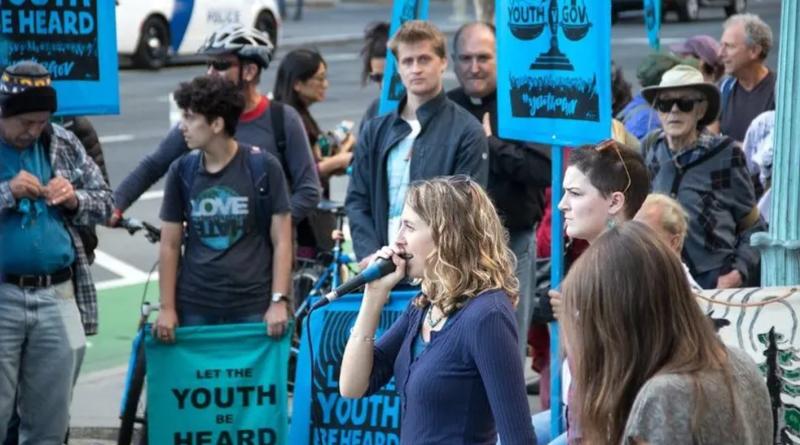‘Dismay But No Surprise’ As U.S. Court Quashes Landmark Climate Lawsuit

A United States appeals court panel has dismissed a lawsuit from 21 young people who said the government’s energy policies violate their right to be protected from climate change.
The May 1 court order for Juliana v. United States likely puts an end to the legal efforts of the young people, for whom the case has been going on for a significant portion of their lives.
A three-judge panel of the 9th U.S. Circuit Court of Appeals said the case should have been dismissed in 2020 when the court first weighed in on the matter, reports Reuters. Back then, judges had ruled that courts cannot mandate broad policy changes that are better left to the government’s political branches—Congress and the executive.
The plaintiffs had since trimmed the lawsuit to seek only a declaration that their rights have been violated, but the court responded that lawsuits must address harms that can be remedied by courts.
The order marks a symbolic defeat for many climate and environmental advocates fighting for more ambitious action from governments to push back against the fossil fuel industry. But the case, which started nearly a decade ago, was always a long shot, with legal experts expressing “dismay but not surprise” at the outcome, writes Robinson Meyer for The Atlantic.
“As the kids’ legal team argues, fixing climate change requires the full-scale transformation of the country’s energy system,” Meyer writes. “This kind of detail-oriented policy-making always makes judges nervous.”
How The Case Progressed
In a 2015 lawsuit, the young plaintiffs had argued that the U.S. government enabled fossil fuel use and extraction while knowing those actions cause catastrophic global warming. Noting that climate change jeopardizes their health and property through impacts like wildfires, floods, and storms, they said U.S. energy policies that contribute to climate change violated their right to due process and equal protection under the U.S. constitution.
In 2016, a district court denied the government’s effort to dismiss the lawsuit, arguing that the claims were suitable for consideration by a court. But then in 2020, the appeals court disagreed, and the judges “reluctantly” sent the case back to the district court for reconsideration after ruling that the problems presented by the plaintiffs were meant for the government—not the court.
However, since a separate legal case at that time was addressing a similar issue, the district court argued it was justified in ruling in favour of the plaintiffs, and sent the case back to the appeals court—again. This time, the government responded by issuing a writ of mandamus asking the appeals court to enforce its earlier ruling. It was this request that the recent order referred to, with the judges granting the request and sending it back for the district court to dismiss, “without leave to amend.”
A Matter of Standing
The U.S. government as the defendant and the appeals court both acknowledged that climate change is a real and growing threat that would harm future generations. But they disagreed with the plaintiffs and the district court that a court should decide how that harm should be handled.
The appeals court thus came to different conclusions about whether the young people had standing to request relief from the government for violating their right to a stable climate system that can sustain human life.
Defining rights in this way is a problem for a court, said Peter Teachout, a constitutional law specialist at Vermont Law and Graduate School. The framing leaves open questions about how to set a standard for protecting a “right to a stable climate system” and how a court can manage that standard.
“As the appeals court found the first time around, that is a judgment for the legislative bodies,” he told The Energy Mix.
Importantly, the rulings focused on whether the young people had standing to have their case considered at all. Evaluating standing is a technique courts use to conserve judicial resources, limiting court involvement to situations they have clear standards to consider so they can make effective decisions. Those limitations are important for managing the courts’ authority, Teachout said, even when the problem they are considering is as real and important a threat as climate change.
“To come out otherwise would result in giving courts the power to act as a sort of ‘environmental czar,’” he said.
Courts rely on reasoning from past cases to define protocols for answering legal questions in a systematic way. For standing, judges look to meet three main criteria: the plaintiff needs to have suffered a real injury; there needs to be a connection between that injury and the actions of the defendant; and the court needs to be able to make a ruling that is likely to remedy—or redress—the injury.
In 2020, the appeals court agreed with the district court that the young people’s injuries from climate change were real, and that there was a connection to the defendant because the government’s fossil fuel policies were a “substantial factor” causing the harm.
But the appeals court disagreed that the courts could do anything about it. The majority ruling found it was beyond their power “to order, design, supervise, or implement the plaintiffs’ requested remedial plan where any effective plan would necessarily require a host of complex policy decisions entrusted to the wisdom and discretion of the executive and legislative branches.”
“The appeals court is saying, ‘how is a court to decide whether some government action or inaction violates an asserted ‘right to a sustainable environment?’” said Teachout. “Or, ‘what standard should a court employ to make such a decision?’”
He added that the case may have gone differently with a different approach. The same plaintiffs may have had standing if they had claimed that a particular violation of federal water or air quality standards, for example, had a direct and immediate impact on their own health.
“In those contexts, plaintiffs would be able to establish all three elements required to show standing: actual injury, direct causation and, crucially, judicial redressability,” he said.
Dissenting Opinion
Siding with the plaintiffs in the appeals court rulings was one dissenting opinion in the 2020 decision written by [pdf] Judge Josephine Staton. Unlike the other judges in that decision, Staton saw the right claimed by the young plaintiffs as so fundamental that its violation threatened the survival of the entire nation. Staton also argued that the court should not refrain from implementing any redressable measures only because it cannot provide full redressability, nor should it shy away from the “messy business” of making policy or the intimidating task of supervising its implementation.
“I admit these are daunting tasks, but we are constitutionally empowered to undertake them,” she wrote. “There is no justiciability exception for cases of great complexity and magnitude.”
The dissent argued that the court could set a science-based, enforceable standard by which to hold the government accountable, by determining the level of fossil fuel emissions that would irreparably devastate the U.S..
Staton also commented on the argument that the issue should be taken up by the other branches of government. “As the last 50 years have made clear,” she wrote, “telling plaintiffs that they must vindicate their right to a habitable United States through the political branches will rightfully be perceived as telling them they have no recourse.”
What’s Next
The plaintiffs are reportedly exploring their options in the wake of the recent order. The non-profit organization that has represented the young people throughout the proceedings, Eugene, Oregon-based Our Children’s Trust, said it is considering asking to have the case reheard by a full panel of appeals court judges, reports Inside Climate News.
“This is a tragic and unjust ruling, but it is not over,” attorney Julia Olson said in a statement. “President Biden can still make this right by coming to the settlement table.”
Our Children’s Trust has filed other cases making similar arguments about fossil fuel emissions violating rights of young people. One notable case ended with a favorable outcome for 16 youth in Montana last year, and another similar lawsuit by a group of young Hawaiians is due to go to trial in June, reports Reuters.
But as lawsuits are sought as means for advancing climate action, “establishing judicial ‘redressability’ is likely to be a continuing hurdle,” Teachout warned, “unless you have a context where the court can base its decision on violation of standards established by legislation itself.”



